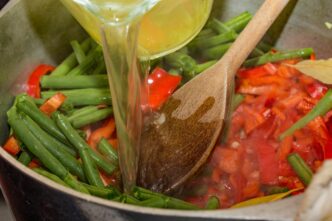A Quick Takeaway
The Story Behind the Trend
How to Make It Work for You
The Community View
Moving to or visiting a new city presents an exciting opportunity to explore new cultures and experiences, but it also poses a unique challenge when it comes to maintaining healthy eating habits. For anyone navigating unfamiliar urban landscapes, the key to finding nutritious food lies in proactive research, embracing local resources, and making mindful choices, ensuring your well-being doesn’t take a backseat to exploration. Understanding how to identify healthy options amidst a sea of new restaurants and grocery stores is crucial for sustaining energy, managing stress, and truly enjoying your new environment.
Initial Exploration and Planning
Before you even pack your bags, dedicate some time to virtual reconnaissance. Utilize online maps and review sites to pinpoint grocery stores, farmers’ markets, and health-conscious restaurants in your new neighborhood. This preliminary research can save you valuable time and prevent impulse decisions driven by hunger in an unfamiliar area.
Download food-finding applications like Yelp, Google Maps, or specialized apps such as HappyCow for plant-based options. These tools provide user reviews, menus, and location details, helping you quickly identify establishments that align with your dietary preferences and health goals. Pay attention to neighborhoods that are known for their fresh produce, diverse culinary scenes, or a high concentration of cafes offering wholesome meals.
Embracing Local Markets and Grocery Stores
Once you arrive, make it a priority to locate and explore local farmers’ markets. These vibrant hubs are often the best source for fresh, seasonal produce, often at more competitive prices than conventional supermarkets. Check local municipal websites or community boards for market schedules and locations, as they can be a cornerstone of your healthy eating strategy.
Familiarize yourself with the local grocery stores in your vicinity. Take time to walk through the aisles, noting where fresh produce, lean proteins, and whole grains are located. Don’t hesitate to ask staff for recommendations on local specialties or healthier alternatives, and look for stores that prioritize organic or locally sourced products if that is important to your diet.
Specialty Food Stores
Beyond general supermarkets, many cities boast a variety of specialty food stores. Health food stores, international markets, or even ethnic grocery stores can be excellent resources for unique ingredients, spices, and dietary staples that might not be available elsewhere. These stores often cater to specific dietary needs, offering a wider range of gluten-free, dairy-free, or organic products.
Navigating Restaurants and Eateries
Eating out is an inevitable part of exploring a new city, but it doesn’t have to derail your healthy intentions. When reviewing menus, actively look for preparation methods like “grilled,” “baked,” “steamed,” or “roasted” rather than “fried” or “creamy.” Don’t shy away from asking for sauces and dressings on the side, allowing you to control the amount you consume.
Practice portion control by sharing meals with companions, requesting half portions, or immediately asking for a to-go box for half your meal. Explore cuisines known for their fresh ingredients and lighter preparations, such as Mediterranean, Japanese, or Vietnamese food. These often feature an abundance of vegetables, lean proteins, and healthy fats.
Making Informed Choices
It is perfectly acceptable to communicate your dietary needs or preferences to restaurant staff. Most establishments are accommodating of requests for ingredient substitutions, such as swapping fries for a side salad or adding extra vegetables to a dish. Being proactive in your ordering can significantly impact the nutritional value of your meal.
Cooking at Home vs. Eating Out
If your new accommodation includes kitchen facilities, prioritize cooking at home as much as possible. Preparing your own meals offers the ultimate control over ingredients, portion sizes, and nutritional content, and it is almost always more cost-effective. Consider meal prepping by cooking larger batches of food at the beginning of the week to ensure healthy options are readily available.
Even with limited kitchen access, you can still make healthy choices. Focus on simple, no-cook meals like large salads with pre-cooked protein, whole-grain sandwiches, or yogurt bowls with fruit and nuts. Keep a supply of healthy staples like oats, canned beans, and fresh produce that requires minimal preparation.
Snack Smart and Stay Hydrated
Always carry healthy snacks with you when you’re out exploring. Options like nuts, seeds, fresh fruit, or protein bars can prevent you from succumbing to unhealthy impulse purchases when hunger strikes between meals. Having a nutritious snack on hand helps maintain stable blood sugar levels and energy throughout your day.
Hydration is equally critical for overall well-being and can often be mistaken for hunger. Carry a reusable water bottle and refill it frequently at public water fountains or cafes. Be mindful of caloric drinks, including sugary sodas, elaborate coffee concoctions, and excessive alcohol, which can add unnecessary calories without providing much nutritional value.
Overcoming Potential Challenges
Time constraints can often lead to unhealthy food choices. Plan your meals and snacks in advance, identify quick healthy takeaway options, and be strategic about your grocery runs. Budget limitations are another common hurdle; prioritize cooking at home, seek out grocery store sales, and frequent farmers’ markets for more affordable produce.
Social pressure can also influence eating habits. When dining with new acquaintances, suggest restaurants with healthy options, or focus on the shared experience and conversation rather than solely on the food. Embrace the culinary diversity of your new city, but always make informed choices that align with your personal health goals.
Sustaining Your Healthy Habits
Successfully navigating healthy eating in a new city boils down to a blend of proactive planning, diligent local exploration, and consistent mindful choices. By investing time in research, leveraging local markets, making smart restaurant decisions, and prioritizing home-cooked meals, you can effortlessly maintain your well-being. Remember, building a sustainable healthy lifestyle is an ongoing journey, and with the right strategies, you can thrive nutritionally no matter where your adventures take you.








